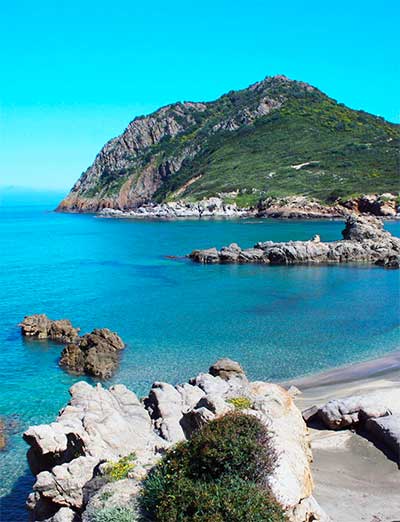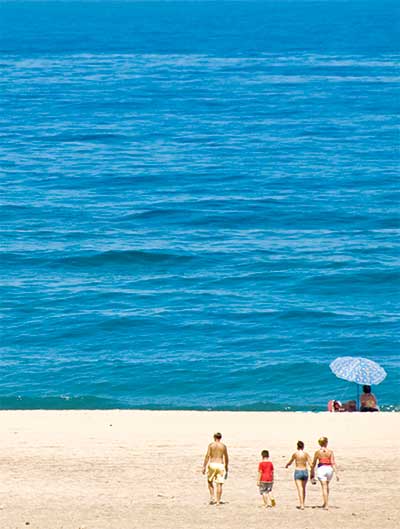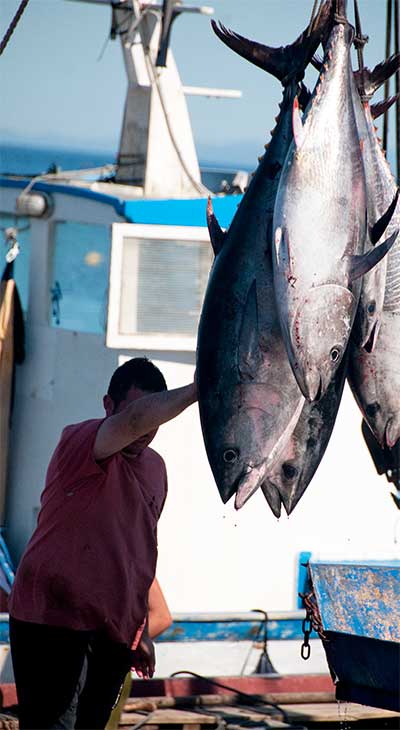The charm of the islands, which is still alive in every one of us, lets our imagination wander in pursuit of an ancestral memory and fascinates us with their obscure mystery. It still remains difficult to understand how a civilisation that came from the sea – such as the Sardinian people of the Neolithic era, who established a relationship with the sea as far back as in the proto-Neolithic era, as it was demonstrated by many archaeological finds (let us think of the S’Adde cave in Macomer or the material discovered near the Cabras pond) – could develop a fear for the sea.
With regard to this, it was highlighted that the “the principal reason and main attraction that led Neolithic populations to Sardinia was, undoubtedly, the existence of lagoons behind the gulf of Oristano, which were teeming with fish, the wetland between Santa Giusta and Terralba, which was full of game and the Monte Arci mountain, which is only about 10 kilometres away from the coast as the crow flies” . Indeed, it was the obsidian found in the Monte Arci mountain (the black gold of prehistory) to determine the intensification of trade flows between the island and the other regions.
However, it was the arrival of the first Phoenician-Punic conquerors to arrest the profitable relationship with the sea, when the management of the most important maritime economic activities was transferred from the local population to the conquerors. Subsequently, under Roman rule, for the non-Romanised people of Sardinia the sea became the theatre of wars and pirate incursions, losing its meaning as “economic space”. This resulted in the onset of a process of detachment from the sea that found even more favourable conditions during the decline of the Roman Empire and further increased during the Byzantine and High Judicial eras.

Hence, we can assert that the reasons behind failure to develop a maritime economy in Sardinia and, in particular, nautical activities and the fishing industry, must be sought in the peculiarity of its historical process. In fact, still today, in all the major centres of the maritime fishing industry, the employees predominantly come from the regions of Liguria, Campania, Lazio and Sicily. In particular, they come from the coastal towns of Camogli, Resina and Ponza among others. Nevertheless, this status quo has been rapidly changing over the last few years, thanks to the fact that young people have had a very positive attitude towards the sea.
The natural conditions of Sardinia – particularly the high temperature of the superficial coastal waters and of the atmosphere, the strong winds and the morphology of the coast (often edged with lagoons and ponds) – have always been ideal for the production of sea salt. Additionally, its geographical position (in the middle of the western Mediterranean Sea) has created favourable conditions for the trade of salt at a large scale.
Over the centuries, the coastal areas had the possibility to establish relationships with the external world and were able to transmit – towards the hinterland – the culture, the ideas and the experiences that had been developed away from home. The coast, over the course of different eras, played a primary role in leading the process of inclusion of Sardinia within the context of the Mediterranean Sea and represented the meeting point between the world beyond the sea (the continents) and the “internal” world. Therefore, it can express in the clearest way the tension that exists between these two geographical areas of opposite qualities.
In the history of humanity, the coast has always represented a frontier and it always had a symbolic power over its population. Whoever arrived to the shore, no matter how, had to stop, having found an impassable limit. Moreover, we must not forget that great part of the history of Sardinia passed through the coastal areas, which were the first to become populated and the first to have to suffer from the impact caused by each domination. Indeed, it was through the sea that the Mycenaean sailors – attracted by the metals and the natural resources of the island – arrived, followed by the Philistines (who came looking for iron). And it was again from the sea that the first Phoenician-Punic colonizer arrived, followed by the Romans, the Vandals, the Byzantines, the Pisans, the Genovese, the Catalans, the Spanish, the Austrian and the Piedmontese. And the sea also brought the violent incursions of the pirates and the privateers.
Over the centuries, the conviction took shape among Sardinian people that “the enemy comes from the sea”. Indeed, enemies apart, the sea has always and inevitably dictated the way in which the relationship with the external world developed. It seldom created opportunities for aggregation, but rather, it accentuated geographical and cultural factors of isolation. Within this continuous dialectics of openness and closeness, over the unstoppable course of time and through centuries of historical vicissitudes, Sardinian people have developed their self-awareness as a “different” ethnical-historic group. A group of people that is “distinct” from their dominators, who contributed to the formation and progressive development of the Italian and European civilisations.
The Mediterranean Sea has represented, over the centuries, the meeting point among the western Christian civilisation, the Islamic culture and the Jewish tradition. A space that, in certain periods, has become a barrier – sometimes crossed by men under arms – but that often represented a channel through which men brought goods, technology and, most importantly, ideas. Different populations who stayed apart for a long time, both physically and metaphorically, but that now are led by the historical events to unite, learn about each other and live together.

Today, when we look at the sea we do not think about the incursions of the Barbarian pirates, but we see a great resource which stimulates solidarity among different and distant populations who share the same destiny. In particular, the Mediterranean represents a privileged area of international cooperation which can contribute to strengthen and spread the awareness of the state of interdependence that exists among the different nations and populations that make up humanity. It can facilitate the necessary integration of the world within a sole, huge and organised community consisting of different nations and civilisations. This must happen in the respect of the ethnic and historic peculiarities of the different cultural heritage and traditions which have their roots in this sea.
While we cannot see beyond the horizon, it still remains true that the longing to discover new lands and new truths, to measure oneself against the dangers and the unknown, is embedded in mankind. Indeed, we can assert that this longing originated with mankind and its quest for a better world. Therefore, in order to win the conditions of isolation and underdevelopment which still today persist (in forms that are different but still insidious), Sardinian people will have to pursue the way of the sea with determination and courage.
However, if the future is in the coast development, particular attention must be paid to the coastal towns. From history, we learnt that during those periods when the coasts were sufficiently populated and had some social groups that were able to guide the acknowledgement of new experiences made elsewhere, the entire island benefited from phases of openness in which Sardinian people worked together towards the common goals of development and civil progress. By contrast, whenever unfortunate historical events caused the depopulation of the coast, periods of underdevelopment and closeness occurred. The consequences of this situation differed according to the specific island’s geographical district in question, but they always translated in ruptures, barriers and regression84.

The conquest and peopling of the coastal areas took place in different phases, during which Sardinian people often had to meet the demands of the dominators and “external” political, economic and cultural identities. Over a long period, the Barbarian incursions dictated the patterns of repopulation in Sardinia. It was under the pressure of the Barbarians that, starting from the 8th century, the coastal towns gradually lost their importance until they almost disappeared. This resulted in the progressive depopulation of the coastal areas and, consequently, the abandonment and decay of the nearby plains. These areas, particularly those near the coast and bordered by ponds and lagoons, became a breeding ground for malaria.
Starting from the late 1950s, after dark centuries and various vicissitudes, the costal areas came to play a central role again, offering the liveliest image of Sardinia recognised by the great public. However, summer tourism has erased some other emblems that are part of the historical and civil tradition of Sardinia. Moreover, the beach, the sea and the sun have been exploited through initiatives that developed outside of the island and were generally alien to the culture and aspirations of its inhabitants.
As a result, the configuration of the coastal urban planning was changed. Presently, the coastal towns are the result of a long and non-linear process of transformation in which their role as fortified towns and emporiums was substituted by new and sometimes contrasting functions. Such alterations were sometimes requested by the local population, but other times dictated by outside interests. Nevertheless, the coastal towns of Sardinia, even the most open to external influences (first of all Cagliari), manage to preserve their historical, cultural and civic traditions.
Undoubtedly, in the question of identity, the protection and appropriate development of the coastal landscape plays a primary role, since the values represented by the coast
are not only those of the environment, but also of the economy, culture and civilization of the island. Therefore, the landscape is not only the natural environment, but also the historical and cultural result of the alterations made by men to the territory. Hence, the landscape is part of a dynamic, permanent and ongoing process, fruit of the dialectical inter-relationship between man and nature. It will depend on the governors to transform this renewed interest in the sea and the shores in new opportunities for development and progress for the Sardinian society at large.
Foto di copertina di Sarah Pinson






More Stories
Il lodevole impegno dei cittadini in difesa dell’isola_di Tarcisio Agus
L’isola sacrificata. Rinnovabili in Sardegna: necessità o volontà di sfruttamento?_di Pier Francesco Lostia
I Templari a Guspini_di Tarcisio Agus